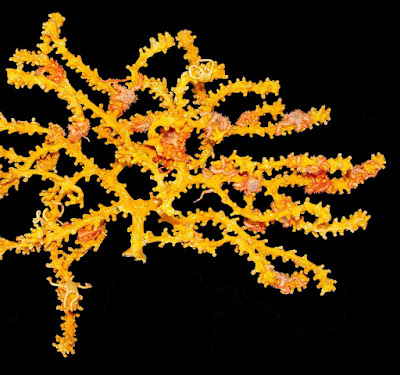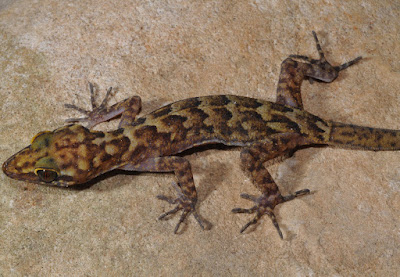[Most Recent Entries] [Calendar View]
Monday, November 26th, 2018
| Time | Event | ||||
| 12:28a | [Cnidaria • 2018] Alaskagorgia splendicitrina • An Unusual New Gorgonian (Anthozoa: Octocorallia: Plexauridae) from the Aleutian Islands of Alaska
Abstract An unusual new species of plexaurid octocoral, Alaskagorgia splendicitrina, is described from a specimen collected in the far west Aleutian Island Archipelago, Alaska, USA. Unusual features that separate it from its only congener include: the vibrant yellow color of the live colony and an arborescent growth form with numerous coiling and twisting branches, the pale yellow color of the sclerites and the lack of small and densely warted double-headed sclerites. The new species is represented by only a single specimen despite extensive sampling in the region during the past several decades; the speculation is that it radiated from the much less explored region to the west. Keywords: Coelenterata, Taxonomy, new species, cold-water coral, subarctic, Aleutian Islands
Taxonomy Class OctocoralliaSuborder Holaxonia Family Plexauridae Gray, 1859 Genus Alaskagorgia Sánchez and Cairns, 2004 Alaskagorgia splendicitrina sp. nov. Etymology. The species designation is derived from the Latin word for “bright” or “vibrant” (=splendius) and the Latin for “lemon-yellow” (=citrina). Common name. Lemon-yellow Squat Gorgonian. Type locality. Stalemate Bank, western Aleutian Islands, .... 184 m. Elizabeth A. Horvath and Robert P. Stone. 2018. Another Unusual New Gorgonian (Anthozoa: Octocorallia: Plexauridae) from the Aleutian Islands of Alaska. Zootaxa. 4524(1); 112–120. DOI: 10.11646/zootaxa.4524.1.8 | ||||
| 7:06a | [Fungi • 2018] Gymnopus nidus-avis • A New Gymnopus Species with Rhizomorphs and Its Record as Nesting Material by Birds (Tyrannidae) in the Subtropical Cloud Forest from eastern Mexico
Abstract A new species of Gymnopus is described on the basis of collections from the subtropical cloud forest of eastern Mexico. Macro- and micromorphological characters, in combination with ITS sequences obtained from fruit body tissues, were used for its taxonomic circumscription. Basidiomata of this species were found growing scattered on fallen twigs of Quercus and also developing abundant long, black, wiry rhizomorphs. The authors discovered that these latter are used as part of nesting material by Mionectes oleaginous (Tyrannidae) inhabiting the subtropical cloud forest studied. A macro- and microscopical description as well as a discussion and illustrations are provided. A new combination in Gymnopus is proposed for Marasmius westii, a synonym of Marasmius brevipes. Keywords: Marasmioid fungi, Neotropical fungi, nesting biology, Omphalotaceae
Gymnopus nidus-avis César, Bandala & Montoya, sp. nov. Holotype: MEXICO. Veracruz: Municipality of Xalapa, Santuario del Bosque de Niebla, Instituto de Ecología A.C., 1343 m a.s.l., gregarious, on fallen twigs of Quercus, 20 April 2016, Cesar 36 (XAL). Diagnosis: Pileus pale brown to brown. Lamellae adnexed, distant, very pale brown. Basidiospores ellipsoid to subcylindrical. Basidia 2–4-spored, narrowly clavate. Cheilocystidia 20–39 × 3–8 µm, irregularly cylindrical, with constrictions and small lateral appendages. Pileipellis hyphae with colourless incrustations; terminal elements appendiculate. Pileus and lamellar tissues clampless. ... Etymology: Referring to the use of rhizomorphs as nesting material by birds. Enrique César, Victor M. Bandala, Leticia Montoya and Antero Ramos. 2018. A New Gymnopus Species with Rhizomorphs and Its Record as Nesting Material by Birds (Tyrannidae) in the Subtropical Cloud Forest from eastern Mexico. MycoKeys. 42: 21-34. DOI: 10.3897/mycokeys.42.28894 | ||||
| 1:30p | [Herpetology • 2018] Six New Cyrtodactylus (Squamata: Gekkonidae) from northeast India; Cyrtodactylus guwahatiensis, C. kazirangaensis, C. septentrionalis, C. jaintiaensis, C. montanus & C. nagalandensis
Abstract We use mitochondrial sequence data to identify divergent lineages within the gekkonid genus Cyrtodactylus in northeast India and use morphological data to describe six new species from within the Indo-Burma clade of Cyrtodactylus. The new species share an irregular colour pattern but differ from described species from the region in morphology and mitochondrial sequence data (>11 % uncorrected pairwise sequence divergence). Three new species are from along the Brahmaputra River and three are from mountains south of the Brahmaputra, including the largest Cyrtodactylus from India and the fifth gecko to be described from a major Indian city, Guwahati. Keywords: Reptilia, Cyrtodactylus khasiensis, endemic species, morphology, Myanmar, ND2, taxonomy .... Results: We recovered the same topology as Agarwal et al. 2014, with moderate support for the south of Brahmaputra clade (Fig. 2). A basal split within the south of Brahmaputra clade separates a mountain (clade M in Agarwal et al. 2014) and lowland clade (clade N), which contain a total of seven, unnamed divergent lineages. The lowland clade includes taxa from lowlands south of the Brahmaputra—the species C. ayeyarwadyensis Bauer, C. khasiensis, and C. tripuraensis Agarwal, Mahony, Giri, Chaitanya and Bauer; and the new species C. guwahatiensis sp. nov., C. kazirangaensis sp. nov., and C. septentrionalis sp. nov. The mountain clade has three species from Myanmar, C. brevidactylus Bauer, C. chrysopylos Bauer, and C. gansi Bauer; and the new species C. jaintiaensis sp. nov., C. montanus sp. nov., C. nagalandensis sp. nov. and the unnamed C. sp. Mizoram from mountains in northeast India. ND2 p-distance results are provided in Table 2 and are discussed below in comparisons sections. We describe six of these genetically divergent lineages from across the lowland and mountain clades as new species below.Cyrtodactylus guwahatiensis sp. nov. Etymology. The specific epithet is a toponym for the type locality of the species, Guwahati, the largest city in Assam and northeast India.
Cyrtodactylus kazirangaensis sp. nov. Etymology. The specific epithet is a toponym for Kaziranga National Park, which is adjacent to the type locality. Kaziranga, a World Heritage Site, is best known for having most of the world’s surviving Indian one-horned rhinoceros, though it has high biodiversity across taxonomic groups. Cyrtodactylus septentrionalis sp. nov. Etymology. The specific epithet is a nominative, masculine, singular, Latin adjective meaning “northern”, as this species is the only known member of the lowland clade (Agarwal et al. 2014) that is found north of the Brahmaputra River, the other five known species of the clade are found south of the Brahmaputra River. Cyrtodactylus jaintiaensis sp. nov. Etymology. The specific epithet is a toponym named after the type locality of the new species in the Jaintia Hills, West Jaintia Hills district, Meghalaya. Cyrtodactylus montanus sp. nov. Etymology. The specific epithet is a nominative, masculine, singular, Latin adjective meaning “pertaining to a mountain” as this species is a member of the mountain clade, and is restricted to a mountainous region in northwestern Tripura. Cyrtodactylus nagalandensis sp. nov. Etymology. This is the first endemic gecko from Nagaland, and the specific epithet is a toponym for the state. Ishan Agarwal, Stephen Mahony, Varad B. Giri, R. Chitanya and Aaron M. Bauer. 2018. Six New Cyrtodactylus (Squamata: Gekkonidae) from northeast India. Zootaxa. 4524(5); 501–535. DOI: 10.11646/zootaxa.4524.5.1 |
| << Previous Day |
2018/11/26 [Calendar] |
Next Day >> |




